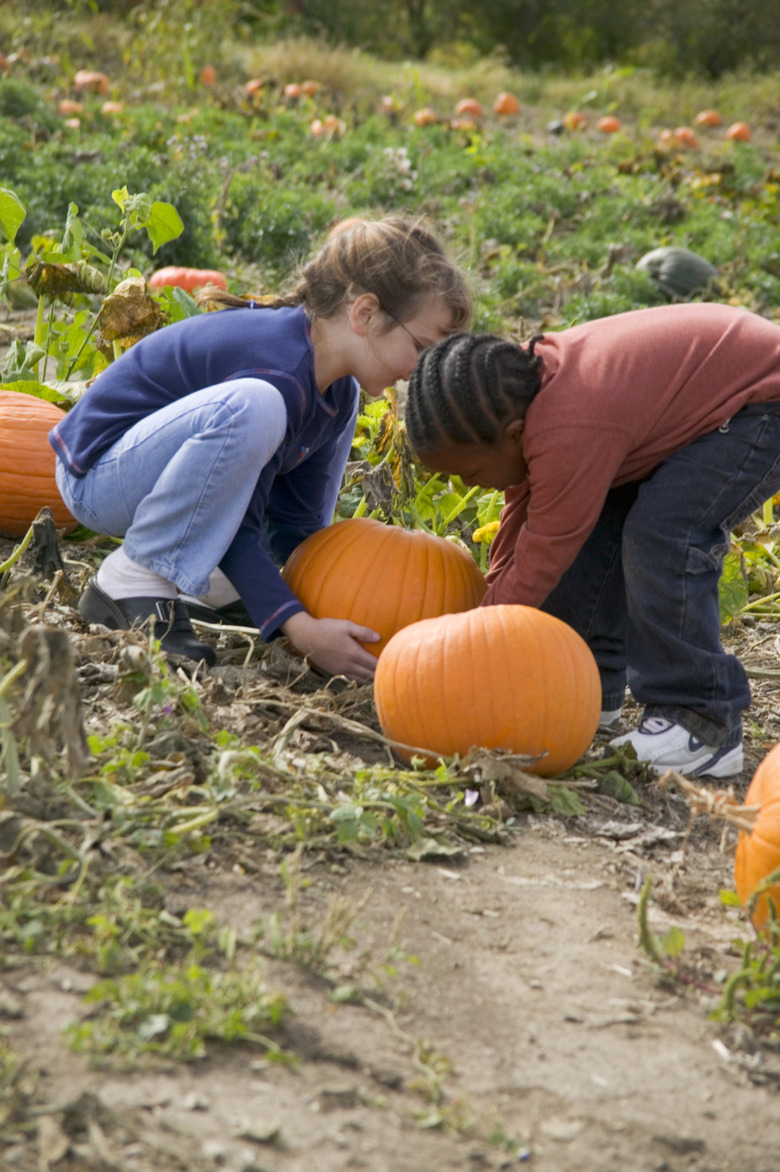What Crop To Rotate With Pumpkins
Crop rotation arranges vegetables into families that have similar vulnerabilities to disease and insects to avoid planting them in succession and increasing the likelihood of transferring problems from one crop to the next. Pumpkins (Cucurbita maxima, C. moschata or C. argyrosperma) fall into the gourd or cucurbits family, which grow on vines. By rotating the pumpkin crop with other crop families in a given planting area, you help the soil maintain a nutrient balance, reduce weed problems and decrease the opportunity for damaging populations of disease spores, eggs and pests to settle into one area long-term and harm your pumpkins.
Soil Fertility
Step 1
Texas A&M Horticulture advises that sweet corn (Zea may) "produces a coarse crop refuse that resists decomposition." However, pumpkin assists in decaying this residue and so works well as a follow-up crop. You must take care with any weed killer you use on the corn, though, as triazine herbicides can persist in the soil and interfere with the pumpkin's growth the following year.
Disease Management
Step 1
According to Ohio State University Extension, "Pumpkins have fewer diseases when they follow grass crops such as field or sweet corn or small grains." Small grains include wheat (Triticum spp.), barley (Hordeum vulgare), rye (Secale cereale), oats (Avena sativa), triticale (x Triticosecal) and spelt (Triticum spelta). Rotation with non-cucurbit crops works to fight soil-borne diseases such as fusarium fruit rot, anthracnose, angular leaf spot, Phytophthora fruit and crown rot and Verticillium wilt. For best effect, any given field should be on at least a three-year crop rotation that leaves it free of pumpkin and vine crops for two or more years between other crops.
- Crop rotation arranges vegetables into families that have similar vulnerabilities to disease and insects to avoid planting them in succession and increasing the likelihood of transferring problems from one crop to the next.
- By rotating the pumpkin crop with other crop families in a given planting area, you help the soil maintain a nutrient balance, reduce weed problems and decrease the opportunity for damaging populations of disease spores, eggs and pests to settle into one area long-term and harm your pumpkins.
Pest Control
Step 1
As pumpkins are members of the cucurbits family, common pests include squash bugs, cucumber beetles and aphids. Planting pumpkins or other crops with similar vulnerabilities, such as cucumbers (Cucumis Sativus), muskmelon (Cucumis melo) or other squashes (Cucurbita) for several years in a row encourages the pests to multiply around the continuous food source. Rutgers University New Jersey Agricultural Experiment Station recommends including alfalfa (Medicago sativa) and legume (Leguminosae) in the crop rotation to improve the soil with organic matter that breaks the pest's life cycle and eradicates the infestation.
Weed Control
Step 1
Many pests hide in weeds and carry disease or cause injury to your plants that increases their susceptibility to disease. Therefore, weed control is an important part of pest and disease management. The University of Kentucky College of Agriculture suggests sorghums (Sorghum spp.), buckwheat (Eriogonum umbellatum), mustards (Brassica spp.), rye, barley, oats, fescues (Festuca arundinacea), perennial rye grass (Lolium perenne) and legumes as cover crops with weed-suppressive abilities.
- As pumpkins are members of the cucurbits family, common pests include squash bugs, cucumber beetles and aphids.
- Rutgers University New Jersey Agricultural Experiment Station recommends including alfalfa (Medicago sativa) and legume (Leguminosae) in the crop rotation to improve the soil with organic matter that breaks the pest's life cycle and eradicates the infestation.
References
- Ohio State University Extension: Chemical Control of Fungal Diseases of Pumpkins in Ohio
- Texas A&M University: Vegetable Rotations, Successions and Intercropping
- Virginia Cooperative Extension: Specialty Crop Profile: Pumpkins
- Royal Horticultural Society: Crop Rotation
- Rutgers University New Jersey Agricultural Experiment Station: Pumpkin Production Using Silicon, Crop Rotation and Mulch
- Penn State Extension: Pumpkin Production
